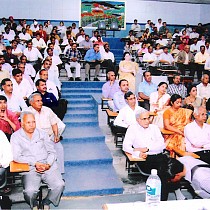POPULATION DYNAMICS OF INSECT PESTS OF GREEN GRAM, VIGNA RADIATA (LINN.) WILCZEK IN SEMI-ARID REGION OF RAJASTHAN
 Department of Agricultural Zoology and Entomology,
S.K.N. College of Agriculture (Rajasthan Agricultural University), Campus-Jobner, Rajasthan-303 329, India
MUKESH NITHARWAL AND K.C. KUMAWAT
Three insect pests species, viz., jassid, Empoasca motti Pruthi; whitefly, Bemisia tabaci (Genn.) and thrips, Caliothrip indicus Bagnall appeared as major insect pests of green gram, Vigna radiata (Linn.) Wilczek in the semi-arid region of Rajasthan. The population commenced from first week of August and remained throughout the crop season. The infestation gradually reached at peak (12.40 jassids, 10.80 whiteflies and 9.40 thrips/three leaves during Kharif 2006 and 13.2 jassids, 11.20 whiteflies and 9.87 thrips/three leaves during Kharif, 2007) in the first week of September during both the years. Among natural enemies, the populations of Chrysoperla carnea (Steph.) and Coccinella septempunctata L. were high, whereas, Monomorium indicum (Linn.), Menochilus sexmaculatus (Fab.) and Brumus suturalis Fab. were low. A significant negative correlation of jassid, whitefly and thrips with maximum temperature (r=–0.61, –0.56 and –0.54 in 2006 –0.65, –0.78 and –0.52 in 2007, respectively) and positive significant correlation of thrips with minimum temperature was observed (r=0.67 in 2006 and 0.56 in 2007, respectively). The data indicated a positive significant correlation of jassid, whitefly and thrips with relative humidity (r=0.62, 0.63 and 0.68 in 2006 and 0.70, 0.56 and 0.72 in 2007, respectively). Key words: Jassid, whitefly, thrips, correlation, temperature, relative humidity.A meagre amount of work has been done on seasonal incidence of the insect pests and their predatory fauna associated with this crop. The effect of abiotic factors on the incidence of insect pests provide suitable know how about the congenial weather conditions for development of insect pests, thus immensely helpful in formulating themanagement strategy against them.
MATERIALS AND METHODSÂ The investigation was carried out at the Agronomyfarm of


